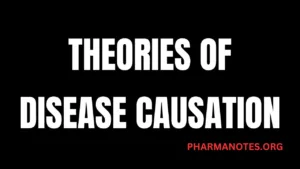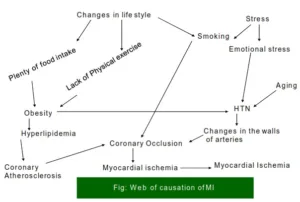THEORIES OF DISEASE CAUSATION

THEORIES OF DISEASE CAUSATION
- Supernatural theory of disease
- Disease is due to super power e.g. gods, evil spirits.
- Tridosha theory of disease
- The doshas or humors are: Vaata (Wind), Pitta (gall), and Kapha (mucus).
- Perfect balance of tridosha is healthy
- Disturbance in balance is disease
- Theory of Contagion
- Spreading of disease by being close to or touching other people.
- Miasmatic theory of disease causation
- Disease is due to noxious air and vapors
- These concepts were prevailing before Louis Pasteur (1822-1895).
- Germ Theory of disease
- In 1860, Louis Pasteur demonstrated the presence of bacteria in air.
- This theory emphasized that the sole cause of disease is microbes.
- The theory generally referred to as one-to- one relationship between disease agent and disease.
Disease agent –> Man –> Disease
- Epidemiological Triad concept
- The germ theory of disease has many limitations
- For example it is well – known that not all exposed to tuberculosis bacilli develops tuberculosis, the same condition in an undernourished person may result in clinically manifest.
MULTI-FACTORIAL ETIOLOGY
- The germ theory of disease or single cause of disease is always not true.
- The germ theory of disease was overshadowed by multi-factorial cause theory in 19th century.
- As a result of advancement in public health, communicable diseases began to decline and are replaced by new type of diseases so called modern disease of civilization.
- Example: Lung cancer, CHD, Mental illness etc. The disease could not be explained on the basis of germ theory of disease and cannot be controlled or prevented on that basis. The realization began that multiple factors are responsible for disease causation where there is no clear single agent.
- The purpose of knowing multiple factors of disease is to quantify and arrange them in priority sequence for modification to prevent particular disease.
WEB OF CAUSATION
- This model of disease causation was suggested by Mac Mohan and Pugh.
- This model is ideally suited in the study of chronic disease where the disease agent is often not known, but is the outcome of interaction of multiple factors.
- The web of causation considers all the predisposing factors of any type and their complex interaction with each other.
- The basic tenets of epidemiology are to study the clusters of causes and combinations of efforts and how they relate to each other.
- The web of causation does not imply that the disease cannot be controlled unless all the multiple causes or chain of causation or at least a number of them are appropriately controlled.
- Sometimes, removal of one link may be sufficient to control disease.

CONCEPT OF CONTROL
- DISEASE CONTROL: The term disease control refers ongoing operation aimed at reducing:
- The incidence of disease.
- The duration of disease and the consequently the risk of transmission.
- The effect of infection including physical and psychological complication.
- The financial burden to the community.
- In disease control, the disease agent is permitted to persist in the community at a level where it ceases to be a public health problem according to the tolerance of local community. For example Malaria control programme. Disease control activities focus on primary prevention
- ELIMINATION: Reduction of case transmission to a predetermined very low level or interruption in transmission. E.g. measles, polio, leprosy from the large geographic region or area.
- ERADICATION: Termination of all transmission of infection by extermination of the infectious agent through surveillance and containment. “All or none phenomenon”. E.g. Small pox
- MONITORING: Defined as “the performance and analysis of routine measurement aimed at detecting changes in the environment or health status of population.” e.g. growth monitoring of child, Monitoring of air pollution, monitoring of water quality etc.
- SURVEILLANCE: Defined as “the continuous scrutiny of the factors that determine the occurrence and distribution of disease and other conditions of ill health.” E.g. Poliomyelitis surveillance programme of WHO.
CONCEPT OF PREVENTION
- Primordial prevention
- Primary prevention
- Secondary prevention
- Tertiary Prevention
LEVELS OF PREVENTION
Primordial Prevention:
- Prevention from Risk Factors.
- Prevention of emergence or development of Risk Factors.
- Discouraging harmful life styles.
- Encouraging or promoting healthy eating habits.
Primary Prevention:
- Pre-pathogenesis Phase of a disease.
- Action taken prior to the onset of the disease:
- Immunization & Chemo-prophylaxis
Secondary Prevention:
- Halt the progress of a disease at its incipient phase.
- Early diagnosis & adequate medical treatment.
Tertiary Prevention:
- Intervention in the late Pathogenesis Phase.
- Reduce impairments, minimize disabilities & suffering.
MODES OF INTERVENTION
- Intervention is any attempt to intervene or interrupt the usual sequence in the development of disease. Five modes of intervention corresponding to the natural history of any disease are:
- Health Promotion
- Specific Protection
- Early Diagnosis and Adquate Treatment
- Disability Limitation
- Rehabilitation
HEALTH PROMOTION
- It is the process of enabling people to increase control over diseases, and to improve their health. It is not directed against any particular disease but is intended to strengthen the host through a variety of approaches (interventions):
- Health Education
- Environmental Modifications
- Nutritional Interventions
- Lifestyle and Behavioral Change
SPECIFIC PROTECTION
- Some of the currently available interventions aimed at specific protection are:
- Immunization
- Use of specific Nutrients
- Chemoprophylaxis
- Protection against Occupational Hazards
- Avoidance of Allergens
- Control of specific hazards in general environment
- Control of Consumer Product Quality & Safety
EARLY DIAGNOSIS & TREATMENT
- Though not as effective and economical as ‘Primary Prevention’, early detection and treatment are the main interventions of disease control, besides being critically important in reducing the high morbidity and mortality in certain diseases like hypertension, cancer cervix, and breast cancer.
- The earlier the disease is diagnosed and treated the better it is from the point of view of prognosis and preventing the occurrence of further cases (secondary cases) or any long term disability.
DISABILITY LIMITATIONS
- The Objective is to prevent or halt the transition of the disease process from impairment to handicap. Sequence of events leading to disability & handicap:
Disease → Impairment → Disability→ Handicap
- Impairment: Loss or abnormality of psychological, physiological/anatomical structure or function.
- Disability: Any restriction or lack of ability to perform an activity in a manner considered normal for one’s age, sex, etc.
- Handicap: Any disadvantage that prevents one from fulfilling his role considered normal.
REHABILITATION
- Rehabilitation has been defined as the ‘combined and coordinated use of medical, social, educational and vocational measures for training and retraining the individual to the highest possible level of functional ability”
- Areas of concern in rehabilitation:
- Medical Rehabilitation
- Vocational Rehabilitation
- Social Rehabilitation
- Psychological Rehabilitation
Also, Visit:
B. Pharma Notes | B. Pharma Notes | Study material Bachelor of Pharmacy pdf